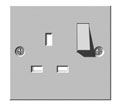The legal requirements have recently been changed which mean that any fixed wiring on a property should be installed by a competent person, this is typically defined as someone qualified and certified in 16th Edition wiring regulations. Failure to observe this requirement could make your house insurance invalid.
The following information is provided so you can understand the requirements that qualified personnel would typically follow to install electricity to outbuildings.
When running power to an outbuilding you first should decide the likely power requirements within the building. If you are only after a light in the outbuilding then there is little point running a 40 amp cable (although some people will argue that you should!)
If however you plan to put a power socket in there then care should be exercised to install the fixed wiring to a level that will support the maximum amount of power drawn by equipment plugged into it. In the UK this will typically be 13 amps unless you plan to install hobby lathes or powered wood working equipment in which case you may need to get a separate supply from the street.
Once you have an idea of the likely power consumption you can work out the fixed cabling requirements, this is achieved by working out what size cables will be required to deliver the power to the outbuilding.
Typically the size of cable gets larger the further you need to run the power or the more power you require on a constant basis. There are a number of web sites that calculate the size of cable.
You should decide how the power will be run to the outbuilding typically there will be 3 options; underground, above ground or surface mounted.
Underground is the most often used as it hides the cable and can if done properly provide additional security for the cable. There is no set depth for the cable to be buried under the ground with regulations specifying a suitable depth for the environment, for a back garden this could mean as little as 150mm if the ground is unlikely to be disturbed by digging, we would recommend however that the cable be laid at least 450mm below ground level, this will allow for any heavy digging that could occur.
The cable should be surrounded in 50mm pea shingle on all sides and have an electric warning tape placed approximately 50mm above the cable, typically on top of the pea shingle. The pea shingle is there to protect the cable from any sharp objects in the ground that could pierce the cable such as flint or glass.

